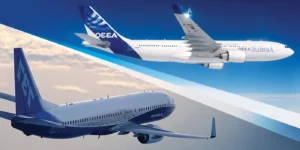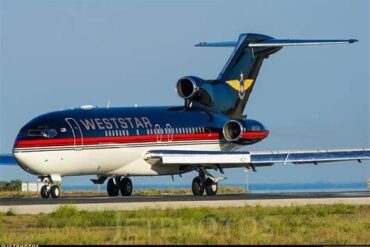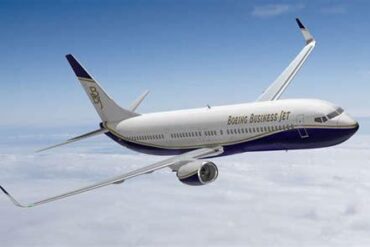Today, let’s explore the exciting competition between the two aviation powerhouses, Boeing vs Airbus.
Epic battles between rivals make for compelling stories. Car lovers ardently debate the prowess of American muscle versus import tuners. Photographers weigh the benefits of Canon versus Nikon gear. Debates continue over iPhones or Androids, Coke or Pepsi.
In aviation, lively discussions swirl around different airplane manufacturers. But it’s the grand face-off between Boeing and Airbus that grabs the most attention, sparking opinions from pilots and passengers alike.
Different Design Philosophies
Boeing and Airbus have fundamentally different design approaches underlying their aircraft. Broad generalizations can be made about their philosophies.
Boeing uses traditional manual flight controls. The pilot’s inputs directly control the plane’s surfaces. Autopilots assist but the pilot retains full authority to override the automation.
In contrast, Airbus uses a unique “fly-by-wire” system. The pilots communicate their intent to onboard computers which then move control surfaces based on pre-programmed parameters for that phase of flight.
With Boeing, a pilot could pitch the aircraft into a stall. Warning systems like stick shakers alert an impending stall. This design approach dates to the 1920s, with new tech but the same focus on training pilots to master the aircraft.
In an Airbus, if a pilot pitches up to purposely stall, the plane will stay within safe limits. The nose rises to a set maximum and power increases for a normal climb.

This exemplifies “fly-by-wire” where the pilot lacks direct control and cannot override built-in flight envelopes. The Airbus lacks tactile feedback, with automated thrust levers instead of manual ones.
Having started in the computer era, Airbus has embraced technology to enhance safety.
Both approaches have merits. We won’t settle the debate today, but the differences are clear. Recent Boeing models also have flight envelope protections.
Company Contrasts: Boeing vs Airbus
These giants have contrasting corporate histories and structures.
Boeing
Boeing’s aviation heritage reaches back to the dawn of flight. The innovative 247 airliner in 1933 enabled the first US coast-to-coast service.
During World War II, Boeing mass-produced iconic bombers like the B-17 and B-29.
Today’s Boeing took shape through mergers, especially with McDonnell Douglas in 1997, ending a major domestic rivalry.
The pioneering 707 jetliner ushered in the Jet Age. The renowned 747 “jumbo jet” revolutionized long-haul wide-body travel.
Boeing builds commercial jets, defense tech, and spacecraft. While based in Seattle, they have a major plant in Charleston, SC.
Airbus

Airbus was founded in 1969 by European governments seeking a competitive counter to American firms. Despite innovations, European companies lacked economies of scale. By pooling resources, they could share the high costs of bigger projects.
Airbus consolidated major manufacturers: France’s Aérospatiale, British Aerospace, Germany’s Deutsche Airbus, and Spain’s CASA. Their first airliner was the 1972 A300, rivalling jets like the Lockheed L-1011.
While evolving, today’s Airbus contains businesses tracing roots back to the European Aeronautic Defence and Space Company, Germany’s DASA, British BAE Systems, Fokker, Eurocopter, and the Bombardier CSeries jets.
Airbus makes commercial jets, helicopters, defense products, rockets, and security tech. Main hubs are in Toulouse, Hamburg, and Seville. More facilities are in Alabama, US and Tianjin, China.
Comparing Airbus and Boeing Models
Seeking to offer airlines comprehensive choices, Boeing and Airbus have developed overlapping product lines.
Head-to-Head Competition
Boeing and Airbus watch the market and each other, delivering better products to win sales. Their dynamic game of one-upmanship aims to unveil innovations that airlines want.
The A300 pioneered an efficient wide-body twin-jet, surpassing rivals like the McDonnell Douglas tri-jets.
This prodded Boeing to make the 767. But Airbus dominated that sector before Boeing responded, growing its influence.
Narrow-Body Rivalry: A320 vs. 737
Both have hugely successful single-aisle jets.
The 737 debuted in 1968. Ongoing upgrades sustained it, especially the popular 737NG variants like the -800. The 737MAX launched in 2017 to counter Airbus’s A320.
Unfortunately MAX crashes led to a global grounding, halting production and sales. After fixes, the MAX returned in 2020 but lost some credibility. This allowed Airbus to become the world’s biggest planemaker.
Overall Boeing has delivered 11,431 737s since 1967.

The A320 debuted in 1987 with innovations like fly-by-wire controls and glass cockpits. The A320neo upgrade came in 2010. Variants include the smaller A318/A319 and larger A321.
With orders, the A320 has surpassed the 737 as the top-selling jet ever. Serving 340 customers, over 10,256 A320s actively expand Airbus’s market reach.
Wide-Body Models: A330/A340 vs. 767/777
Airbus challenged Boeing’s wide-body dominance with the A330 and A340. The medium/long-haul A330 competes strongly with the 767. But the four-engine A340 found limited success against the twin 777. The modern A330 continues thriving.
New-Age Giants: A350 vs. 787 Dreamliner
In 2003, Boeing’s 787 was swiftly followed in 2004 by the Airbus A350. Updating the A330 and 767, these twin jets bring major efficiency, cost, and emissions improvements through new tech and carbon fiber. They represent the state-of-the-art in efficiency.
Jumbo Jet Showdown: A380 vs. 747
For years, Boeing’s iconic 747 “Queen of the Skies” led size.
Airbus responded boldly with the even bigger double-decker A380. Both four-engine planes targeted long, high-volume routes to minimize per seat costs.
Challenging their outlook, COVID-19 casts doubt on sustained demand for such big aircraft. Now efficient long-range twins like the A350 and 777 can fly the same routes for less.
Unfortunately both the A380 and 747 have been retired by their makers, though many still operate worldwide.

Current Aviation Landscape
As a duopoly, Airbus and Boeing dominate airline sales.
While some new entrants exist, none yet challenge the Boeing/Airbus share. Both firms have accused the other of unfair practices. Boeing claims Airbus gets illegal subsidies, undercutting Boeing on price to take share. Airbus alleges Boeing improperly leverages US ties for contracts.
The Future: Boeing vs Airbus
With jumbos fading, focus is on new medium-sized models to replace 767 and A330 fleets. Airbus has the A330neo while Boeing’s plans remain unknown.
Ultimately the rivals share many similarities too. Both maintain huge global supply and manufacturing networks. Interestingly, many Airbus jets are made in the US Alabama facility.
Boeing and Airbus will continue fiercely competing for market share, offering competitive pricing and seeking big orders. Every deal is a hard-won success and opportunity to introduce new products.
So where do you stand in this epic Boeing vs Airbus debate?


















